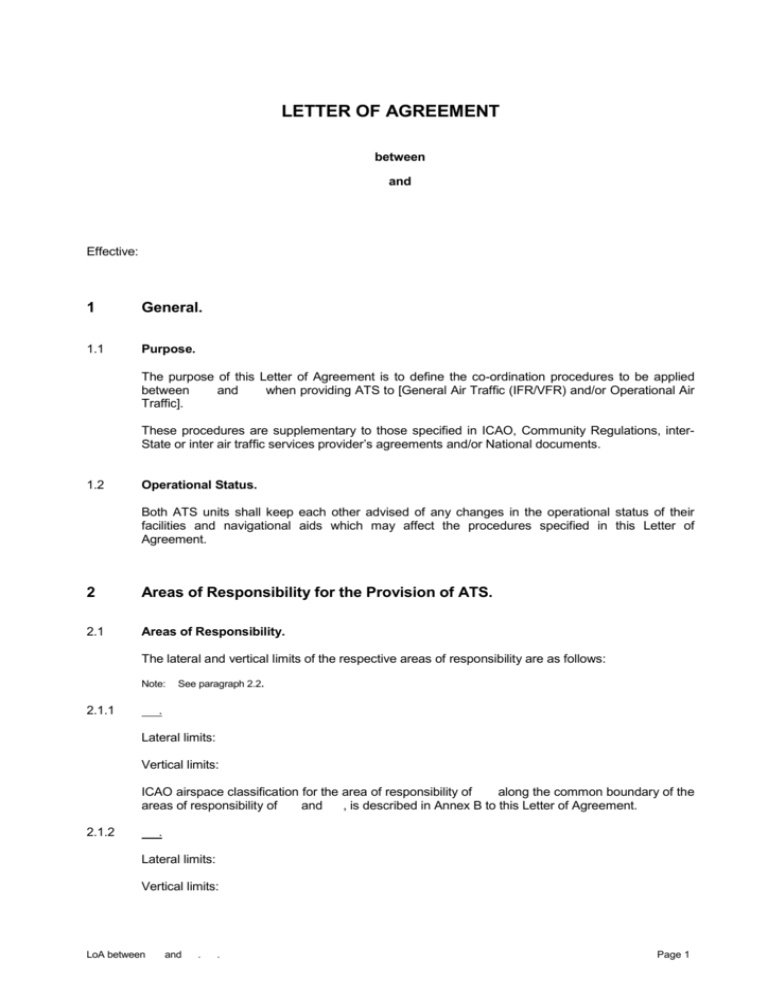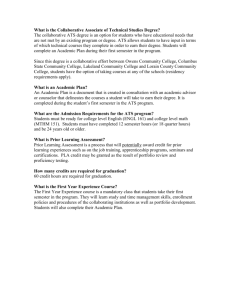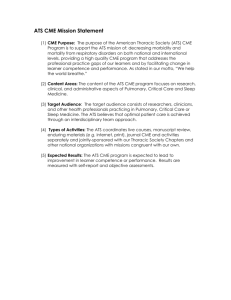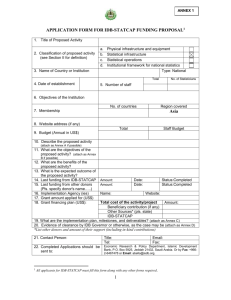LoA Word Template
advertisement

LETTER OF AGREEMENT between and Effective: 1 General. 1.1 Purpose. The purpose of this Letter of Agreement is to define the co-ordination procedures to be applied between and when providing ATS to [General Air Traffic (IFR/VFR) and/or Operational Air Traffic]. These procedures are supplementary to those specified in ICAO, Community Regulations, interState or inter air traffic services provider’s agreements and/or National documents. 1.2 Operational Status. Both ATS units shall keep each other advised of any changes in the operational status of their facilities and navigational aids which may affect the procedures specified in this Letter of Agreement. 2 Areas of Responsibility for the Provision of ATS. 2.1 Areas of Responsibility. The lateral and vertical limits of the respective areas of responsibility are as follows: Note: 2.1.1 See paragraph 2.2. . Lateral limits: Vertical limits: ICAO airspace classification for the area of responsibility of along the common boundary of the areas of responsibility of and , is described in Annex B to this Letter of Agreement. 2.1.2 . Lateral limits: Vertical limits: LoA between and . . Page 1 ICAO airspace classification for the area of responsibility of along the common boundary of the areas of responsibility of and , is described in Annex B to this Letter of Agreement. 2.2 Areas for Cross Border Provision of ATS. 2.2.1 Areas for Cross Border Provisions of ATS by . Within the [YYYY FIR/UIR] the provision of ATS in accordance with the airspace classification is performed by within the following area(s): 2.2.1.1 [Designation of Area]- see Appendix [X]. Lateral limits: Vertical limits: Airspace classification: Details of national regulations of [State A], which differ from ICAO procedures, to be applied within the area by : 2.2.2 Areas for Cross Border Provision of ATS by . Within the [ZZZZ FIR/UIR] the provision of ATS in accordance with the airspace classification is performed by within the following area(s): 2.2.2.1 [Designation of Area] - see Appendix [X+1]. Lateral limits: Vertical limits: Airspace classification: Details of national regulations of [State B], which differ from ICAO procedures, to be applied within the area by : 2.2.3 Other Areas for Cross Border Provision of ATS. Areas for cross-border provision of ATS defined with other co-ordinating air traffic services units along the common boundary of the areas of responsibility of and are described in Annex B to this Letter of Agreement. 2.2.4 Alerting Service. The ATS Unit responsible for the provision of ATS shall provide alerting service and shall coordinate with the appropriate rescue coordination Centre as required. 2.2.5 Territorial Matters. 2.3 Special Provisions. LoA between and . . Page 2 3 Procedures. 3.1 The procedures to be applied by Agreement: Annex A: Annex B: Annex C: Annex D: Annex E: Annex F: Annex G: Annex H: and are detailed in the Annexes to this Letter of Definitions and Abbreviations Area of Common Interest Exchange of Flight Data Procedures for Co-ordination Transfer of Control and Transfer of Communications ATS Surveillance Based Co-ordination Procedures Supplementary Procedures Checklist of Pages 3.2 These procedures shall be promulgated to the operational staff of the ATS units concerned. 4 Revisions and Deviations. 4.1 Revision of the Letter of Agreement. The revision of the present Letter of Agreement, excluding Annexes and their Appendices, requires the mutual written consent of the signatories. 4.2 Revision of the Annexes to the Letter of Agreement. The revision of Annexes to the present Letter of Agreement requires the mutual written consent of the representatives of the respective ATS units designated by the respective signatories, normally the Heads of Operations at the respective units. 4.3 Temporary Deviations. When necessary, the Supervisors of the ATS units concerned may introduce, by mutual agreement and for a specified time period, temporary modifications to the procedures laid down in the Annexes to the present Letter of Agreement. 4.4 Incidental Deviations. Instances may arise where incidental deviations from the procedures specified in the Annexes to this Letter of Agreement may become necessary. Under these circumstances air traffic controllers are expected to exercise their best judgement to ensure the safety and efficiency of air traffic. LoA between and . . Page 3 5 Cancellation. 5.1 Cancellation of the present Letter of Agreement by mutual agreement of the respective Approving Authorities may take place at any time. 5.2 Cancellation of this Letter of Agreement by either Approving Authority is possible at any time, provided that the cancelling party declares its intention to cancel the Letter of Agreement with a minimum pre-notification time of [time period] before the date the cancellation is to take effect. 6 Interpretation and Settlement of Disputes. 6.1 Should any doubt or diverging views arise regarding the interpretation of any provision of the present Letter of Agreement, or in case of dispute regarding its application, the parties shall endeavour to reach a solution acceptable to both of them. 6.2 Should no agreement be reached, each of the parties shall refer to a higher level of its national aviation administration, to which the dispute shall be submitted for settlement. 7 Validity. This Letter of Agreement becomes effective and dated [date]. , and supersedes the Letter of Agreement between [Place, date] [Place, date] ________________________________ [name] ________________________________ [name] [Place, date] [Place, date] ________________________________ [name of representative of ATS-unit 1] [ATS-unit 1] ________________________________ [name of representative of ATS-unit 2] [ATS-unit 2] LoA between and . . Page 4 Appendix [X] Paragraph 2.2.1.1 LoA between and . . Page 5 Appendix [X+1] Paragraph 2.2.2.1 LoA between and . . Page 6 Annex A. Definitions and Abbreviations. Effective: Revised: [date] A.1 Definitions. A.1.1 ATS Area of Responsibility. An airspace of defined dimensions where a sole ATS unit has responsibility for providing air traffic services. A.1.2 Area of Common Interest. A volume of airspace as agreed between 2 ATS Units, extending into the adjacent/subjacent Areas of Responsibility, within which airspace structure and related activities may have an impact on air traffic co-ordination procedures. A.1.3 Division Level (DL). The level dividing two super-imposed areas of responsibility for the provision of ATS. A.1.4 General Air Traffic (GAT). All flights which are conducted in accordance with the rules and procedures of ICAO and/or the national civil aviation regulations and legislation. A.1.5 Operational Air Traffic (OAT). All flights which do not comply with the provisions stated for GAT and for which rules and procedures have been specified by appropriate national authorities. A.1.6 Reduced Vertical Separation Minimum (RVSM). A vertical separation minimum of 300 m (1 000 ft) which is applied between FL 290 and FL 410 inclusive, on the basis of regional air navigation agreements and in accordance with conditions specified therein. A.1.6.1 RVSM Approved Aircraft. Aircraft that have received State approval for RVSM operations within the EUR RVSM airspace. A.1.6.2 RVSM Entry Point. The first reporting point over which an aircraft passes or is expected to pass immediately before, upon, or immediately after initial entry into EUR RVSM airspace, normally the first reference point for applying a 300 m (1 000 ft) vertical separation minimum between RVSM approved aircraft. LoA between and . . Annex A Page A 1 A.1.6.3 RVSM Exit Point. The last reporting point over which an aircraft passes or is expected to pass immediately before, upon, or immediately after leaving EUR RVSM airspace, normally the last reference point for applying a 300 m (1 000 ft) vertical separation minimum between RVSM approved aircraft. A.1.7 Release. A.1.7.1 Release for Climb. An authorization for the accepting unit to climb (a) specific aircraft before the transfer of control. Note: A.1.7.2 The transferring unit/sector remains responsible within its Area of Responsibility for separation between the transferred aircraft and other aircraft unknown to the accepting unit/sector, unless otherwise agreed. Release for Descent. An authorization for the accepting unit to descend (a) specific aircraft before the transfer of control. Note: A.1.7.3 The transferring unit/sector remains responsible within its Area of Responsibility for separation between the transferred aircraft and other aircraft unknown to the accepting unit/sector, unless otherwise agreed. Release for Turn. An authorization for the accepting unit to turn (a) specific aircraft away from the current flight path by not more than 45 o before the transfer of control. Note: A.1.8 The transferring unit/sector remains responsible within its Area of Responsibility for separation between the transferred aircraft and other aircraft unknown to the accepting unit/sector, unless otherwise agreed. State Aircraft. For the purposes of EUR RVSM, only aircraft used in military, customs or police services shall qualify as State aircraft. LoA between and . . Annex A Page A 2 A.2 Abbreviations. ABI Advance Boundary Information LAM Logical Acknowledge Type Designator) ACI* Area of Common Interest ACT Activation Message AIP Aeronautical Information Publication AMC* Airspace Management Cell AoR* Area of Responsibility ATC Air Traffic Control ATS Air Traffic Services ATSP* (Message LoA* Letter of Agreement LOF* Logon Forward Message (OLDI) MAC* Message for Abrogation of Coordination (OLDI) MFC* Multi Frequency Coding (telephone system) NAN* Next Authority Notified Message (OLDI) Air Traffic Services Provider NM Nautical Mile CBA* Cross Border Area OAT* Operational Air Traffic CDR* Conditional Route OLDI On-line Data Interchange COP* Coordination Point ORCAM Originating Region Code Assignment Method CPDLC Controller-Pilot Data Link Communications PAC* Pre-activation Message (OLDI) DL* Division Level REV* Revision Message ETO Estimated Time Over Significant Point RTF Radio Telephony FDPS Flight Data Processing System RVSM Reduced Vertical Separation Minimum FIC Flight Information Centre SSR Secondary Surveillance Radar FIR Flight Information Region TSA* Temporary Segregated Airspace FMP* Flow Management Position UIR Upper Flight Information Region GAT* General Air Traffic VFR Visual Flight Rules ICAO International Civil Aviation Organization IFR Instrument Flight Rules Note: LoA between Abbreviations marked with an * are non-ICAO abbreviations. and . . Annex A Page A 3 Annex B. Area of Common Interest. Effective: Revised: [date] B.1 Airspace Structure and Classification within the Area of Common Interest. B.1.1 [YYYY FIR/UIR]. Area Vertical limits Airspace Classification [Special regulations relevant to the provision of ATS in the ACI]. B.1.2 [ZZZZ FIR/UIR]. Area Vertical limits Airspace Classification [Special regulations relevant to the provision of ATS in the ACI]. B.2 Sectorisation. The sectorisation within the ACI is shown in Appendix 1 of Annex B. B.3 Special Areas within the Area of Common Interest. B.3.1 Areas for Cross-Border Provision of ATS defined with other ATS Units within the ACI. [description of areas for cross-border provision of ATS defined with other ATS units, if applicable reference to Appendix 2 of Annex B. (map)] B.3.2 Other Areas. [description of any other relevant areas, if applicable - reference to Appendix 2 of Annex B (map)] LoA between and . . Annex B Page B 1 B.4 Non-published Co-ordination Points. COPs that are not related to significant points published in relevant AIPs [COP] LoA between and [co-ordinates] . . Annex B Page B 2 Appendix 1 of Annex B Sectorisation. LoA between and . . Annex B Page B 3 Appendix 2 of Annex B Designated special areas. LoA between and . . Annex B Page B 4 Annex C¹. Exchange of Flight Data. (with automatic data exchange) Effective: Revised: [date] C.1 General. C.1.1 Basic Flight Plans. Basic flight plan data should normally be available at both ATS Units. C.1.2 Current Flight Plan Data. Messages, including current flight plan data, shall be forwarded by the transferring ATS unit to the accepting ATS unit either by automatic data exchange or by telephone to the appropriate sector/position. C.1.2.1 Automatic Data Exchange. ABI/ACT/LAM/PAC/REV/MAC messages are exchanged between the two ATS units in accordance with Appendix 1 to Annex C1. C.1.2.2 Verbal Estimates. For conditions that are not supported by the automatic data exchange, verbal estimates will be exchanged. A verbal estimate shall be passed to the appropriate sector at the accepting ATS unit at least [value to be decided] minutes prior, but not earlier than 30 minutes before the aircraft is estimated to pass the transfer of control point. A verbal estimate shall contain: a) Callsign. Note: b) To indicate that the flight plan is available, the accepting ATS unit should state aircraft type and destination after having received the callsign. SSR code: Note: Normally, the notification of a SSR code indicates that the selection of that code by the aircraft was verified. c) ETO for the appropriate COP as laid down in Annex D to this LoA. d) Cleared level, specifying climb or descent conditions if applicable, at the transfer of control point. Requested level if different from cleared level. e) Other information, if applicable. Normally, verbal estimates will not be passed in parallel with ACT messages. In all cases, verbally passed data shall take precedence over data exchanged automatically. LoA between and . . Annex C¹. Page C¹ 1 C.1.2.3 Failure of Automatic Data Exchange. In the event of a failure which prevents the automatic transfer of data, the Supervisors shall immediately decide to revert to the verbal exchange of estimates. After recovery from a system failure, the Supervisors shall agree as to when they will revert to automatic data exchange. C.1.3 Non-availability of Basic Flight Plan Data. If the accepting ATS unit does not have basic flight plan data available, additional information may be requested from the transferring ATS unit to supplement the ACT message or a verbal estimate. C.1.4 Revisions. Any significant revisions to the flight data are to be transmitted to the accepting ATS unit. Time differences of [value to be decided] minutes or more are to be exchanged. Changes to the co-ordinated levels within [value to be decided] minutes of the ETO for the transfer of control point are subject to an Approval Request. C.1.5 Expedite Clearance and Approval Requests. Whenever the minimum time of [value to be decided] minutes for a verbal estimate, or those prescribed in Appendix 1 to Annex C1 for ACT messages, cannot be met, either an expedite clearance request, an approval request (or a PAC), as appropriate, shall be initiated. C.2 Means of Communications and their Use. C.2.1 Equipment. The following lines are available between Line Type : Amount Data Line Telephone Lines C.2.2 and [X] [X] Additional Information not applicable Verbal Co-ordination. All verbal communications between non-physically adjacent controllers should be terminated with the initials of both parties concerned. Exchange of flight plan data, estimates and control messages by voice shall be carried out in accordance with the following tables: LoA between and . . Annex C¹. Page C¹ 2 C.2.2.1 Messages from to . Receiving Sector/COPs Message [name of sector] Flight Plan Data and Estimates [COPs] Control Messages, Expedite Clearances, Approval Requests and Revisions Position Extension Position Extension Surveillance Co-ordination Flight Plan Data and other Co-ordination FIC Supervisor: Switchboard: Telefax: FMP: AMC: Degraded mode operations: C.2.2.2 Messages from to .. Receiving Sector/COPs Message [name of sector] Flight Plan Data and Estimates [COPs] Control Messages, Expedite Clearances, Approval Requests and Revisions Surveillance Co-ordination Flight Plan Data and other Co-ordination FIC Supervisor: Switchboard: Telefax: FMP: AMC: Degraded mode operations: LoA between and . . Annex C¹. Page C¹ 3 C.3 Failure of Ground/Ground Voice Communications. C.3.1 Fall-Back Procedures for Co-ordination. In the event of failure of the direct lines between the co-ordinating partners, co-ordination may be effected via: a) b) c) C.3.2 switchboard, or [other common co-ordination partner], or public telephone: : [additional listing of available public telephone numbers to the operations room and the relevant working positions, if available] : [additional listing of available public telephone numbers to the operations room and the relevant working positions, if available] Alternate Fall-Back Procedures for Co-ordination. In case of communications failure where the alternatives described in paragraph C.3.1 above are not available or practicable, pilots shall be instructed, at least 5 minutes prior to the transfer of control point, to pass flight data on the appropriate frequency of the accepting ATS unit for the purpose of obtaining an ATC entry clearance from the accepting ATS unit. If the accepting ATS unit cannot issue an entry clearance to the pilot upon his initial contact, the pilot shall be instructed to inform the transferring ATS unit accordingly via RTF. The transferring ATS unit shall hold the aircraft within its AoR and after a minimum of 10 minutes instruct the pilot to re-establish RTF contact with the accepting ATS unit. This procedure shall be repeated until an onward clearance has been obtained from the accepting ATS unit. LoA between and . . Annex C¹. Page C¹ 4 Appendix 1 to Annex C1 Automatic Data Exchange. ABI/ACT/LAM messages are exchanged between the two ATS units in accordance with the table below: Time and/or Distance Parameters Messages COPs Messages from to Messages from to ABI ACT LAM REV PAC MAC LOF NAN LoA between and . . Annex C¹. Page C¹ 5 Annex C². Exchange of Flight Data. (without automatic data exchange) Effective: Revised: [date] C.1 General. C.1.1 Basic Flight Plans. Basic flight plan data should normally be available at both ATS units. C.1.2 Current Flight Plan Data. Messages, including current flight plan data, shall be forwarded by the transferring ATS unit to the accepting ATS unit by telephone to the appropriate sector/position. C.1.2.1 Verbal Estimates. A verbal estimate shall be passed to the appropriate sector at the accepting ATS unit at least [value to be decided] minutes prior, but not earlier than 30 minutes before the aircraft is estimated to pass the transfer of control point. A verbal estimate shall contain: a) Callsign. Note: b) To indicate that the flight plan is available, the accepting ATS unit should state the aircraft type and the destination after having received its callsign. SSR code: Normally, the notification of a SSR code indicates that the selection of that code by the aircraft was verified. Note: c) ETO for the appropriate COP as laid down in Annex D to this LoA. d) Cleared level, specifying climb or descent conditions if applicable, at the transfer of control point. Requested level if different from cleared level. e) C.1.3 Other information, if applicable. Non-availability of Basic Flight Plan Data. If the accepting ATS unit does not have basic flight plan data available, additional information may be requested from the transferring ATS unit to supplement verbal estimates. C.1.4 Revisions. Any significant revisions to the flight data are to be transmitted to the accepting ATS unit. Time differences of [value to be decided] minutes or more are to be exchanged. LoA between and . . Annex C² Page C² 1 Changes of co-ordinated levels within [value to be decided] minutes of the ETO for the transfer of control point are subject to an Approval Request. C.1.5 Expedite Clearance and Approval Requests. Whenever the minimum time for verbal estimate of [value to be decided] minutes cannot be met, an Expedite Clearance Request or an Approval Request, as appropriate, shall be initiated. C.2 Means of Communications and their Use. C.2.1 Equipment. The following lines are available between and Line Type Amount Telephone Lines C.2.2 : Additional Information [X] Verbal Co-ordination. All verbal communications between non-physically adjacent controllers should be terminated with the initials of both parties concerned. Exchange of flight plan data, estimates and control messages by telephone shall be carried out in accordance with the following tables: C.2.2.1 From to . Receiving Sector/COPs Message [name of sector] Flight Plan Data and Estimates [COPs] Control Messages, Expedite Clearances, Approval Requests and Revisions Position Extension Surveillance Co-ordination FIC Flight Plan Data and other Co-ordination Supervisor: Switchboard: Telefax: FMP: AMC: Degraded mode operations: LoA between and . . Annex C² Page C² 2 C.2.2.2 From to . Receiving Sector/COPs Message [name of sector] Flight Plan Data and Estimates [COPs] Control Messages, Expedite Clearances, Approval Requests and Revisions Position Extension Surveillance Co-ordination FIC Flight Plan Data and other Co-ordination Supervisor: Switchboard: Telefax: FMP: AMC: Degraded mode operations: C.3 Failure of Ground/Ground Voice Communications. C.3.1 Fall-Back Procedures for Co-ordination. In case of failure of the direct lines between the co-ordinating partners, co-ordination may be effected via: a) b) c) C.3.2 switchboard, or [other common co-ordination partner], or public telephone: : [additional listing of available public telephone numbers to the operations room and the relevant working positions, if available] : [additional listing of available public telephone numbers to the operations room and the relevant working positions, if available] Alternate Fall-Back Procedures for Co-ordination. In case of communications failure where the alternatives described in paragraph C.3.1 above are not available or practicable, pilots shall be instructed, at least 5 minutes prior to the transfer of control point, to pass flight data on the appropriate frequency of the accepting ATS unit for the purpose of obtaining an ATC entry clearance from the accepting ATS unit. If the accepting ATS unit cannot issue an entry clearance to the pilot upon his initial contact, the pilot shall be instructed to inform the transferring ATS unit accordingly via RTF. The transferring ATS unit shall hold the aircraft within its AoR and after a minimum of 10 minutes instruct the pilot to re-establish RTF contact with the accepting ATS unit. This procedure shall be repeated until an onward clearance has been obtained from the accepting ATS unit. LoA between and . . Annex C² Page C² 3 Annex D. Procedures for Co-ordination. Effective: Revised: [date] D.1 General Conditions for Acceptance of Flights. D.1.1 Co-ordination of flights shall take place by reference to the coordination point (COP) and in accordance with the appropriate levels specified for the relevant route (see paragraphs D.2 and D.3). D.1.2 Flights shall be considered to be maintaining the co-ordinated level at the transfer of control point unless climb or descent conditions have been clearly stated by use of crossing conditions in the PAC/ACT or by verbal co-ordination, except if otherwise described in paragraphs D.2 or D.3. D.1.3 If the accepting ATS unit cannot accept a flight offered in accordance with the conditions specified above, it shall clearly indicate its inability and specify the conditions under which the flight will be accepted. D.1.4 For any proposed deviation from the conditions specified in this Annex (e.g. COP, route or level) the transferring unit shall initiate an Approval Request. D.1.5 The accepting ATS unit shall not notify the transferring ATS unit that it has established ground-air communications with the transferred aircraft unless specifically requested to do so. The Accepting Unit shall notify the transferring Unit in the event that communication with the aircraft is not established as expected. D.2 ATS-Routes, Co-ordination Points and Level Allocation. Available ATS-routes, COPs to be used and level allocation to be applied, unless otherwise described in paragraph D.3, are described in the tables below. D.2.1 Flights from to ATS-Route . COP Level Allocation Special Conditions [see para D.3.....] LoA between and . . Annex D Page D 1 D.2.2 Flights from from to ATS-Route . COP Level Allocation Special Conditions [see para D.3.....] D.3 Special Procedures. D.3.1 Flights from to . D.3.2 Flights from to . D.4 Co-ordination of Status of Special Areas in the Area of Common Interest. Both ATS units shall keep each other advised on any changes of the activation times of CDRs and of activation times for the following CBAs, TSAs and AMC-manageable restricted or danger areas: D.4.1 shall inform about changes for the following areas: D.4.2 shall inform about changes for the following areas: D.5 VFR flights. D.5.1 Flights from to . D.5.2 Flights from to . LoA between and . . Annex D Page D 2 Annex E. Transfer of Control and Transfer of Communications. Effective: Revised: [date] E.1 Transfer of Control. The transfer of control takes place at the AoR-boundary, unless otherwise specified in paragraph E.3. E.2 Transfer of Communications. The transfer of communications shall take place not later than [time, distance or level parameter, and not sooner than time, distance or level parameter] before the transfer of control and as specified in paragraph E.3, unless otherwise co-ordinated. When Controller-Pilot Data Link Communications (CPDLC) is used in both ATS units, the transfer of CPDLC shall commence concurrently with the transfer of voice communications. NOTE: Frequencies: E.3 : (Sector and FIC frequencies) : (Sector and FIC frequencies) Specific Points for Transfer of Control and Transfer of Communications. ATS-Route Transfer of Control Point Transfer of Communications to LoA between and . . Annex E to Page E 1 Annex F. ATS Surveillance Based Co-ordination Procedures. Effective: Revised: [date] F.1 General. F.1.1 Transfer of identification and transfer of control between and will be subject to the serviceability of the respective surveillance systems and two-way direct speech facilities between the controller working positions. F1.2 In case of any doubt about the identity of an aircraft, nothing in the provisions of this Annex, prevents the use of others methods for the identification of an aircraft. F.2 Transfer of Aircraft Identification. F.2.1 Transfer of aircraft identification between methods for the transfer of identification]. F.2.2 When discrete SSR codes are used for transfer of identification, they shall be assigned in accordance with ORCAM. F.2.3 Any change of SSR code by the accepting ATS Unit may only take place after the transfer of control point. F.2.4 The accepting ATS Unit shall be notified of any observed irregularity in the operation of SSR transponders or ADS-B transmitters. F.3 Transfer of Control. F.3.1 If it becomes necessary to reduce or suspend transfers of control, a value to be decided minutes prior notification shall be observed, except in emergency situations. F.3.2 Description of vectoring procedures along common AoR-boundary. F.3.3 Transfer of Control without systematic use of the bi-directional speech facilities (Silent Transfer of Control) and is normally performed by [one or more Transfer of control may be effected without systematic use of bi-directional speech facilities provided the minimum distance between successive aircraft about to be transferred is value to be specified NM and constant or increasing. F.3.3.1 The transferring controller shall inform the accepting controller of any level, speed or vectoring instructions given to aircraft prior to its transfer and which modify its anticipated flight progress at the point of transfer. Note: F.3.3.2 When using Mach-number speed control, pilots concerned shall be instructed to report their assigned mach-number to the accepting ATS Unit upon initial contact. The accepting controller may terminate the silent transfer of control at any time, normally with an advance notice of value to be defined minutes. LoA between and . . Annex F Page F 1 F.3.4 Transfer of Control with use of the bi-directional speech facilities. Transfer of control may be effected with the use of bi-directional speech facilities, provided the minimum distance between the aircraft does not reduce to less than value to be specified NM, and: identification has been transferred to or has been established directly by the accepting controller; the accepting controller is informed of any level, speed or vectoring instructions applicable to the aircraft at the point of transfer; communication with the aircraft is retained by the transferring controller until the accepting controller has agreed to assume responsibility for providing ATS surveillance service to the aircraft. Thereafter, the aircraft should be instructed to change over to the appropriate frequency and from that point is the responsibility of the accepting controller. F.4 Reduced Longitudinal Separation. F.4.1 Transfer of control of the aircraft on the same track or crossing tracks, whether at the same level, climbing or descending, may be effected provided that a minimum longitudinal separation of 3 minutes exists between aircraft, the relevant aircraft are continuously flight path monitored and the transferring ATS Unit has ensured that the actual distance between the aircraft does not reduce to less than 20 NM. LoA between and . . Annex F Page F 2 Appendix 1 to Annex F. ATS Surveillance Coverage in the Area of Common Interest. LoA between and . . Annex F Page F 3 Annex G. Supplementary Procedures Effective: Revised: [date] LoA between and . . Annex G Page G 1 Annex H. Checklist of Pages. Page Date Page Date Page Date Page Date Effective: Revised: [date] LoA between and . . Annex H Page H 1

![June 2013 [DOCX 24.38KB]](http://s3.studylib.net/store/data/006990913_1-45414924984da7777020f5c1725fdda9-300x300.png)




